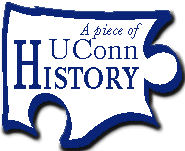This is an archived article. For the latest news, go to the Advance Homepage. For more archives, go to the Advance Archive/Search Page  | |||
|
The grand marshal of the annual Homecoming Parade in 1990 was Alan T. Busby, returning to his alma mater for the second time since his graduation in 1918 from what was then Connecticut Agricultural College.
Busby, who died in 1992, was the first black graduate of the University of Connecticut. He arrived in Storrs in 1914 with only enough money for one semester. With the help of President Charles Beach, he found a job on the campus farm to cover the $290 a year cost of his education. "I had to work every minute possible," Busby said in an interview with the Advance in 1990. "Even when I graduated, I still owed the school some money, and I paid it off when I returned from the war (World War I) in the spring of 1919." Busby came to Connecticut Agricultural College with three friends from Worcester, Mass., because enrollment at Massachusetts Ag (now the University of Massachusetts) was full. During his 1990 visit, Busby recalled working with other students to harvest ice from the Duck Pond (now known as Swan Lake) along North Eagleville Road. They sawed out a channel to the ice house that once stood on the banks of the pond, then cut blocks of ice and floated them into the channel for storage."We had to make sure that we had enough ice to last us from one winter to the next," said Busby of that pre-refrigeration era. An honor student at Connecticut Agricultural College, Busby taught for nearly 50 years, including 20 years at Alcorn A&M College in Mississippi (now Alcorn State University), and 25 years at Lincoln University in Jefferson City, MO. Busby was awarded UConn's Distinguished Alumni Award in 1969, and during his four-day stay in Storrs in 1990 he was honored by both the Black Alumni Association and the Alpha Phi Alpha fraternity. The University has not been immune to racial problems over the decades. In 1974, for example, black students held a sit-in at the Wilbur Cross Library to protest the proposed split-up of the anthropology department and the need for more space for the African American Cultural Center. In the 1930s, less than a year after the college became known as Connecticut State College, there was an incident involving the men's basketball team and a rival team's race prejudice. On Tuesday, January 28, 1934, the men's team was suited up for a game against the Coast Guard at New London when Coast Guard entered a protest against Connecticut State College's Harrison B. Fitch, a sophomore from New Haven and apparently the first black member of the Connecticut men's team. According to an unpublished manuscript by Walter Stemmons, Coast Guard said in its protest that more than half their students were from the South, and that "there had been a long tradition that no 'negro' players be allowed to engage in contests at the Academy."
Tempers flared, and the Connecticut State College team threatened to leave. Later, they took to the floor with Fitch and warmed up. Fitch sat out the game on the bench, however. The 1934 Nutmeg Yearbook notes that the game "received wide publicity, due to the barring of 'Honey' Fitch, Connecticut State athlete. Because of the argument the game didn't start until 11 o'clock, and was rough and full of fouls." Connecticut won, 31 to 29. Soon after game day, according to Stemmons, a joint statement was issued by Roy Guyer, Connecticut State College's athletic director, and the athletic director for the Coast Guard Academy. The statement said the incident had not impaired the relationship between the two institutions, but confirmed that "In the future, any student would be eligible to participate in athletic events between them." It is not known what happened to Fitch. [For an update, please go to the Feb. 2, 2004 issue. ]He left Connecticut State College at the end of the 1934 academic year, after two years at the college: in the 1933 yearbook he is listed as a freshman and pictured with the men's freshman basketball team; the next year's Nutmeg lists him as a sophomore and pictures him with the varsity team. Mark J. Roy Source: University archives, Dodd Research Center. |


